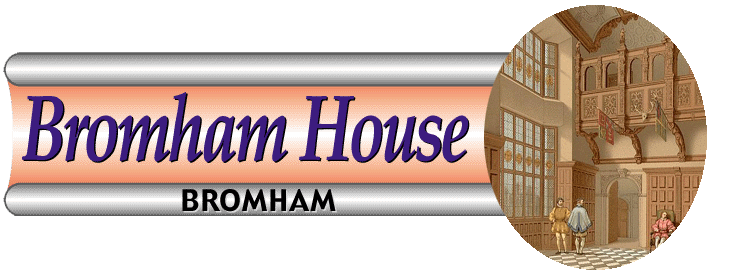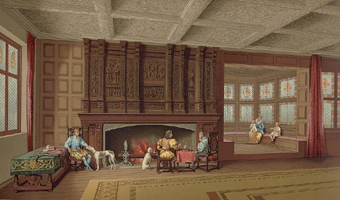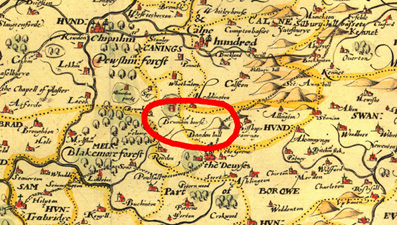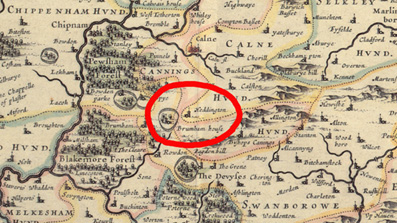
|
This
fine house was destroyed by the Royalist troops from the Devizes Garrison
during the Civil War, being put to fire on 5th May 1645 in a direct
act of deliberate vandalism.
|
When Sir Richard Beauchamp (Lord St. Amand) died in 1508 without legitimate issue, the Manor of Bromham Roches was passed onto John Bayntun, his first cousin thrice removed. John Bayntun and Richard Beauchamp had common ancestors and the Roche's blood came down to the Bayntun family through two separate lines – the daughters and heiresses of John Roche (d1401). John Bayntun (1460 - 1516) was the next heir and representative of Joan Roche, who was married to one of his ancestors. Prior to that, nine generations of the Bayntun family had lived at Faulston House in the parish of Bishopstone in the Valley of Ebble, in the south of the county of Wiltshire about 5 miles south west of Salisbury and approximately 30 miles from Bromham before they moved to Bromham Hall. Old Bromham Hall was situated at Bromham Park, east of the village, on a site later known as Netherstreet, standing close to the old Western Road which passed over Roundway Hill. The site is still known as Bromham House Farm, and prior to the Civil War, became one of the usual halting places for gentry on their way to Bath. John Bayntun moved into his new residence while the rest of the family dispersed to occupy Beauchamp property throughout the land. John died in 1516 and his son and heir, Sir Edward Bayntun (1480 - 1544) added to and enlarged the house, which was decorated with stone carvings in the new and fashionable style with some materials taken from the ruins of Devizes Castle and from an old manor house at Corsham. From then on it was known as Bromham House.
The archway, or gatehouse to Sir Edward's house was reconstructed on the instructions of Queen Catherine of Aragon, as a gift and expression of gratitude to her friend for some time, Sir Edward. It is said that originally the arch was at the entrance to Stanley Abbey, Wiltshire. The Abbey was purchased by Sir Edward Bayntun at the time of the Dissolution of the Monasteries in 1536 and was completely demolished, but the gatehouse was dismantled and re-erected at the entrance to Bromham House. Today this beautiful landmark is known to locals as Spye Arch. The arch bears the royal arms of the Tudors beneath the oriel window in the upper storey, and in the spandrels of the arch forming the gateway, those of Sir Edward Bayntun, its original builder, and his first wife Elizabeth Sulliard, the daughter of Sir John Sulliard, Chief Justice of the Common Pleas. Royalty were frequent visitors to Bromham House which has been described as one of the most famous houses in the country and both King Henry VIII and King James I are known to have stayed there. In early June 1535, King Henry VIII, Queen Anne Boleyn and the rest of his court, left Greenwich Palace for some months and embarked on a route through Gloucestershire and Wiltshire. Local gentlemen who favoured reform, like Sir Edward Bayntun, were singled out for a Royal visit. The party stayed at Sir Edward's residence at Bromham House for one week, from the 27th August through to the 3rd September 1535. Thomas Cromwell, the Chancellor, had just caught up with the travelling party at that time, where a letter written by him was dated, from Bromham, during that week. Evidence exists in town records that King James I also visited Bromham House three times in 1618, 1620 and stayed there again from 29th to 31st July 1623. However the House was destroyed by the Royalist troops from the Devizes Garrison during the Civil War, being put to fire on 5th May 1645. The picturesque Tudor gateway which escaped the destruction, was again rebuilt from the ruins and placed where it now stands at the top of Bowden Hill – which was one of the entrances to the Bayntun's new home at Spye Park. It was moved there by Sir Edward Bayntun (1593 - 1657) when the family built another fine house, following the destruction of Bromham House. This second home - Spye Park House - was also eventually destroyed by fire. The ruins of Bromham House were abandoned after the fire in 1645 before the above mentioned new house was built sometime around 1654, but in those years in between, a lot of the materials was salvaged from the ruins from the old house. But before any rebuilding took place, Sir Edward petitioned for the confirmation of his title to the manor which had been claimed by the Commonwealth Commissioners as having belonged to the Bishop of Salisbury. Sir Edward said that he had lost all his evidence of ownership when the Royalist's burnt down his house during the Civil War. There is nothing remaining of Bromham House today, except for Spye Arch, still standing in its new position at the top of Bowden Hill, having escaped fire and destruction for the second time. Unfortunately no illustration or painting of the old house exists which is a shame. In 1755 Sir Edward Bayntun-Rolt set up his eldest son, Edward, with a Commission in the Guards and he and his wife, Suzanna, settled at Bromham Farm. Today Bromham House Farm, a modern red brick building, stands a mile north-east of the village on the site of the ancient mansion of the Bayntun family. There is no trace of any of the ruins of the house, but for a couple of foundation stones buried beneath the ground.
|



